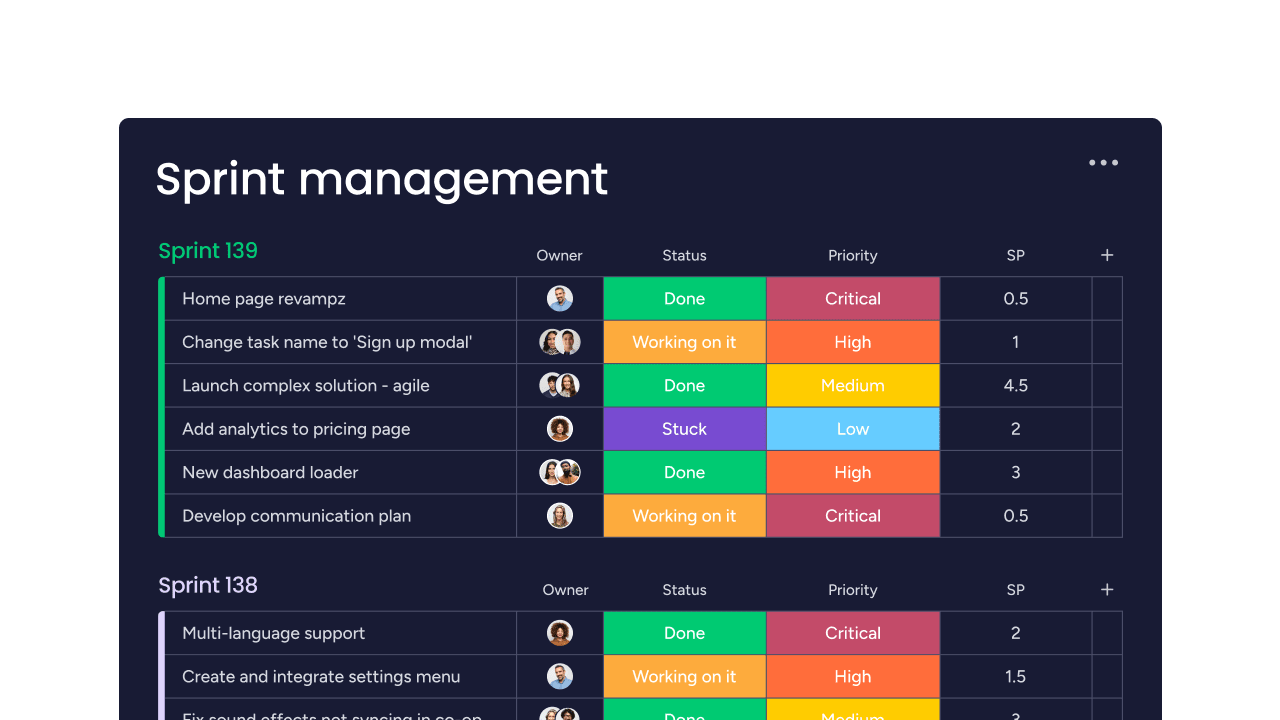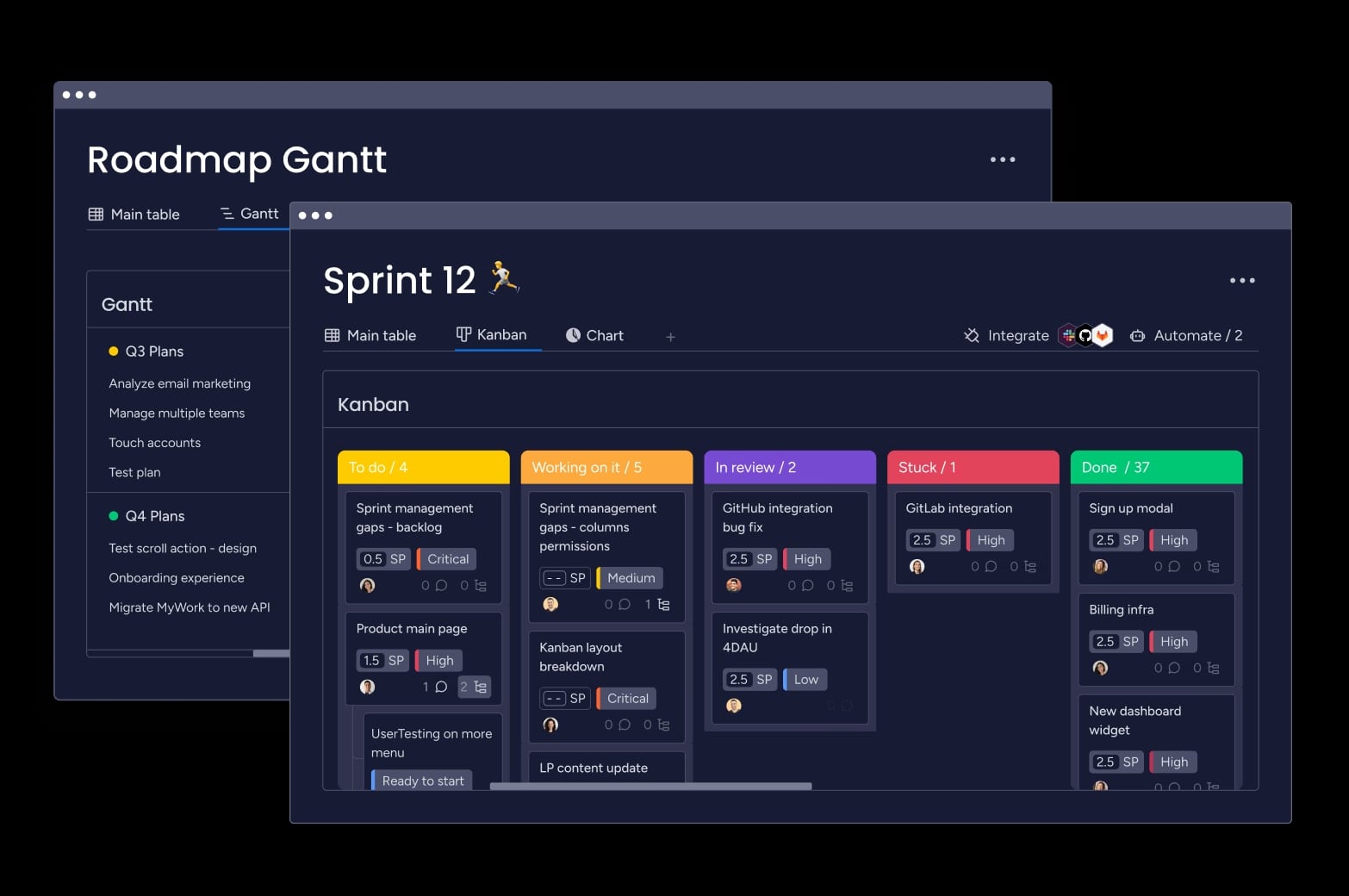In software development, the push to go faster is constant. But chasing speed often leads to burnout and unpredictable release cycles. The most effective engineering teams know that a sustainable pace and predictability matter more than short bursts of output. This essential shift in focus from raw speed to predictable consistency is managed by understanding and tracking development velocity.
Mastering velocity is about more than just tracking points. It is about creating a system that gives your team visibility, control, and the confidence to deliver on their commitments. With the right process and platform in place, you can move from reactive firefighting to predictable, high-impact delivery.
This handy post breaks down how to use development velocity the right way and explores how to measure it accurately, use it for predictable sprint planning, and align your team’s capacity with business goals. It also walks through the common pitfalls to avoid and seven practical ways to increase your team’s velocity without causing burnout. It all begins with a clear definition of what you are measuring.
Key takeaways
- Predictability over speed: focus on consistency. A team delivering 30 story points every sprint is more valuable than one swinging wildly between 50 and 10 points.
- Measurement and planning: development velocity measures how much work your team consistently completes per sprint, helping you make realistic commitments and avoid overcommitment and burnout.
- Team metric only: never use velocity to compare teams or judge individual performance, as this destroys collaboration and renders the metric useless for planning.
- Systemic improvement: boost velocity by streamlining workflows, reducing technical debt strategically, and implementing CI/CD pipelines rather than pushing developers to work faster.
- Real-time tracking: Modern platforms including monday dev connect velocity tracking to your entire development workflow with real-time dashboards and cross-department visibility, eliminating manual spreadsheet updates.
What is development velocity?
Development velocity is the amount of work your team completes in a specific timeframe — usually measured in story points per sprint. This means you’re tracking how much your team can realistically deliver, not how fast individual developers code.
It shows you the sustainable pace at which you can deliver working software. For example, a 2021 study published in the Journal of Software Engineering found that structured velocity tracking can improve estimation accuracy by about 40%, creating a stronger foundation for any agile transformation.
Development velocity: predictability not speed
Development velocity represents the average work your team completes during each sprint or iteration. You measure this in story points, features, or user stories — whatever unit makes sense for your team.
Here’s what makes velocity unique: it’s about predictability, not speed. A team that consistently delivers 30 story points every sprint is more valuable than one that swings between 50 and 10 points.
Velocity in Agile software development
Velocity started in Scrum as a way to help teams make realistic sprint commitments. At the end of each sprint, you count what got done. Over time, this creates a pattern you can trust.
The significant value of velocity lies in its ability to prevent overcommitment and mitigate team burnout. By establishing a reliable baseline — for instance, consistently completing 25 story points per sprint — teams can make data-driven decisions and avoid committing to an unrealistic workload, such as 40 points.
Story points vs time-based metrics
You have two main ways to measure velocity, and choosing the right one is critical for how your team plans and tracks progress. Understanding the differences between story points and time-based metrics will help you select the approach that best fits your team’s workflow and project complexity.
- Story points: measure the relative complexity and effort required, rather than raw time. This approach is highly effective when the nature or size of work items varies widely.
- Time-based metrics: track the actual hours or days expended on tasks. This method is best suited for teams where work items are generally uniform and predictable.
- Hybrid approach: combines aspects of both story points and time tracking. This provides a comprehensive overview that is particularly useful for complex projects with diverse stakeholders.
Most Agile software development teams prefer story points because they account for uncertainty. A “three-point story”
might take different amounts of time depending on who does it, but the complexity stays the same.

How to measure software development velocity
Velocity isn’t about how fast your team works — it’s about how predictably they deliver. Measuring it correctly helps you plan smarter, forecast accurately, and spot delivery risks early.
Here’s how to calculate velocity, track it effectively, and understand the supporting metrics that reveal your team’s true performance.
Calculating sprint velocity
The math is simple: add up all completed story points and divide by the number of sprints. Most teams use a three-sprint rolling average to smooth out the bumps.
Let’s say your team completes 25, 30, and 35 points over three sprints. Your average velocity is 30 points. Now you have a baseline for planning.
To get an accurate velocity reading, you must track a few essential data points consistently. Paying attention to these factors ensures your velocity metric remains a reliable tool for forecasting and planning.
- Completed work only: only items marked as “done” should be included.
- Consistent sprint length: two-week sprints every time.
- Team changes: note when people join or leave.
- External factors: holidays and training days matter.
Development velocity tracking methods
You can track velocity manually with spreadsheets, but most teams quickly outgrow this approach. Software development tools significantly reduce errors and overhead.
Agile platforms automate the heavy lifting. They pull data from your sprint boards and calculate velocity automatically, eliminating the need for manual Friday afternoon spreadsheet updates.
Platforms like monday dev take this further by connecting velocity tracking directly to your entire Agile workflow. With such systems, your dashboards update in real time as work moves through the pipeline, ensuring immediate data visibility.
Engineering velocity metrics that matter
Velocity alone doesn’t tell the whole story. Smart teams track additional engineering metrics that reveal the health of their development process:
- Cycle time: how long from start to done?
- Lead time: how long from request to delivery?
- Throughput: how many items completed?
- Velocity variance: how consistent are you?
These metrics work together. High velocity means nothing if your cycle time keeps growing or quality drops.
Why should you track developer velocity?
Developer velocity isn’t just a productivity metric — it’s a lens into how efficiently your team delivers value. Tracking it gives you the insight to plan realistically, allocate resources wisely, and align engineering output with business goals.
Here’s how measuring velocity builds predictability, connects technical work to outcomes, and helps teams operate at their true capacity:
- Predictability and sprint planning: velocity provides a reliable historical average, transforming sprint planning into a data-driven process where teams can confidently look at the sprint backlog and commit to genuinely achievable workloads. This consistency builds trust and eliminates uncertainty in delivery forecasts.
- Aligning with business outcomes: velocity becomes powerful by connecting engineering output directly to business results. Solutions like monday dev facilitate this by linking development metrics to high-level business dashboards, ensuring full visibility into how engineering work drives organizational value.
- Team capacity and resource optimization: velocity data reveals the team’s genuine sustainable capacity, helping leaders diagnose systemic issues like under-delivery caused by technical debt or excessive meetings. Understanding this capacity allows for intelligent, data-driven decisions that improve overall engineering productivity.
5 common velocity pitfalls to avoid
Velocity can be a powerful planning tool — or a misleading metric if used incorrectly. Many teams fall into the same traps that distort data, hurt morale, and undermine trust in the process.
Here are five common mistakes to watch for and how to avoid them to keep your velocity metrics meaningful and accurate.
Treating velocity as productivity
Velocity measures predictability, not productivity. A team building complex features might have lower velocity than one fixing simple bugs.
Using velocity to judge productivity encourages gaming. Teams inflate estimates or pick easy work to look good. This destroys the planning value velocity provides.
Comparing different team velocities
Every team has its own velocity baseline. Comparing Team A’s 40 points to Team B’s 25 points tells you nothing useful.
Different teams use different scales, work on different systems, and have different definitions of “done.” Focus on each team’s consistency, not the numbers.
Gaming velocity metrics
Teams might inflate story points or break work into tiny pieces to boost velocity. This makes the metric useless for planning.
Real velocity improvement comes from removing bottlenecks and improving processes, not manipulating numbers.
Ignoring quality for speed
Pushing for higher velocity often leads to cut corners. The technical debt piles up until everything slows to a crawl.
Define “done” to include quality standards. Only count work that’s truly complete, tested, and ready for production.
Measuring individual developer velocity
Individual velocity tracking kills collaboration. Software development is a team sport — measuring individuals creates competition instead of cooperation.
Focus on team velocity. Celebrate when the whole team delivers, not when one person completes the most points.

7 ways to increase development velocity
Boosting velocity isn’t about working faster, it’s about working smarter. Sustainable improvements come from better systems, clearer collaboration, and smarter tooling, not longer hours.
Below are seven proven ways to streamline your development process, reduce friction, and help your team deliver more value with less effort.
1. Streamline your development workflow
Look at how work flows through your team. Where does it get stuck? What steps add no value?
Common workflow improvements that boost velocity:
- Standardize processes: everyone follows the same code review steps.
- Find bottlenecks: use data to spot where work piles up.
- Smooth handoffs: clear ownership at each stage.
- Reduce context switching: let developers focus.
2. Reduce technical debt strategically
Technical debt acts as systemic friction within the development process: it significantly increases the effort required for all subsequent work. In fact, analysis by FullScale found that developers waste approximately 33% of their time on technical debt and maintenance instead of building new features. Therefore, fixing technical debt requires a strategic approach, as it cannot be addressed all at once.
Smart debt reduction focuses on high-impact areas:
- Prioritize by pain: fix what slows you down most.
- Schedule refactoring: dedicate time each sprint.
- Prevent new debt: better code reviews and standards.
- Measure impact: track how fixes improve velocity.
3. Implement CI/CD pipelines
By automating the entire process, from pushing code and running tests to deployment, CI/CD accelerates development significantly, reduces wait times, and ensures problems are caught early.
This streamlined workflow allows high-performing teams to often deploy multiple times per day.
4. Enhance developer experience
Small improvements in daily developer life yield big velocity gains. Fast builds, good documentation, and reliable environments matter.
When developers spend less time fighting with their development platform and more time solving problems, velocity naturally increases.
5. Foster cross-functional collaboration
Miscommunication and unclear requirements kill velocity. When developers, designers, and product managers work closely together, fewer things need rework, which improves product development cycles.
This collaboration is supported by advanced platforms like monday dev by keeping everyone on the same page. No more searching through email for that requirements document.
6. Leverage AI coding assistants
AI assistants handle routine coding work so developers can focus on complex problems. For deeper insights into AI for software engineering, explore how teams leverage advanced automations.
Teams using AI report completing features faster while maintaining quality. The AI handles the boring parts.
7. Adopt platform engineering practices
Platform engineering provides developers with self-service infrastructure capabilities. This means that provisioning a test environment or executing a deployment is handled through simple, automated processes.
This self-service approach is critical because it removes dependencies on other teams (e.g., Ops or Infrastructure), thereby allowing developers to maintain focus and accelerate delivery.
Development velocity vs developer productivity
Velocity and productivity measure different things. Understanding the distinction helps you use each metric appropriately.
Velocity tells you how much work your team can reliably complete per sprint. It’s about planning and predictability.
On the other hand, productivity measures efficiency — how much value you create per unit of effort. It’s about working smarter.
Both metrics matter, but they answer different questions. Use velocity for sprint planning. Use productivity for process improvement.
AI impact on software velocity
AI is redefining what development speed means. It’s not just helping teams write code faster — it’s changing how they test, deploy, and optimize every part of the delivery process.
From intelligent coding assistants to automated testing and infrastructure optimization, AI accelerates both the pace and quality of software development.
Coding velocity with AI assistants
AI coding assistants act like a skilled pair programmer who never gets tired. They complete routine code, suggest improvements, and catch errors.
This assistance means developers write more code with less effort. But more importantly, they write better code that needs less rework.
Automated testing for faster delivery
AI-powered testing finds bugs humans miss. It generates test cases, runs them automatically, and reports issues immediately, making test-driven development even more efficient.
Faster testing means faster feedback. Developers fix problems while the code is fresh in their minds.
Platform engineering acceleration
AI optimizes your development infrastructure. It predicts when you’ll need more resources, identifies performance bottlenecks, and suggests improvements.
This intelligence keeps your platform running smoothly, so developers never wait for environments or deployments.

Best development velocity platforms for modern teams
Modern teams need platforms that do more than count story points. They need integrated systems that connect planning, execution, and measurement. For example, an Agile SDLC approach ensures the entire software lifecycle is streamlined.
The best platforms share key characteristics that set them apart:
- Automated tracking: no manual data entry.
- Real-time visibility: see progress as it happens.
- Flexible workflows: adapt to how you work.
- Predictive insights: spot problems before they hit.
Transform your development velocity with monday dev
Intelligent platforms like monday dev give your team the tools to track, understand, and improve velocity without adding overhead, making it a powerful ally for any Agile transformation. Everything connects: from backlog to deployment through a unified Work OS built specifically for development teams.
Real-time velocity tracking and visibility
See your velocity trends update automatically as work moves through your workflow. No end-of-sprint scramble to update spreadsheets.
Sprint Widget in monday dev automatically calculates your team’s velocity by tracking completed story points across sprints. Custom dashboards show velocity alongside other key metrics like cycle time, lead time, and throughput — all pulling from the same source of truth. The Velocity Chart widget displays historical trends and rolling averages, helping you spot patterns and forecast capacity. Stakeholders get the visibility they need through read-only dashboard views without interrupting your team.
Flexible workflows that scale with your team
Whether you use Kanban vs Scrum or something unique, monday dev adapts to your process. Start simple and add complexity as you grow.
The platform offers pre-built sprint planning templates with customizable story point fields, burndown charts, and velocity tracking built in. Create custom automations that move items through your workflow stages, trigger notifications when sprints are at capacity, or alert teams when velocity drops below baseline. The platform scales from small teams to large organizations without forcing you to change how you work — add boards, integrate with GitHub, GitLab, or Jira, and connect multiple teams under one workspace.
Cross-department alignment for faster delivery
Development doesn’t happen in isolation. With monday dev, your velocity data connects to product roadmaps and business objectives through cross-board connections and portfolio-level dashboards.
Link sprint boards directly to your product roadmap so stakeholders see how development velocity impacts feature delivery timelines. The platform’s two-way integrations with tools like Slack, Microsoft Teams, and project management boards ensure everyone stays aligned. Use the Workload View to visualize team capacity against committed story points, preventing overcommitment before it happens. This alignment ensures everyone understands how development capacity translates to delivered features and business value.
Frequently asked questions
What is a good development velocity for agile teams?
A good development velocity for Agile project management teams is one that remains consistent and predictable over multiple sprints, regardless of the specific number. Your team’s ideal velocity depends on size, experience, and project complexity — focus on stability rather than hitting a particular target.
How often should development teams measure velocity?
Development teams should measure velocity after each sprint or iteration to maintain accurate capacity data. Review velocity trends monthly or quarterly for strategic planning and resource allocation decisions.
Can development velocity predict project completion dates?
Development velocity can predict project completion dates by dividing remaining work by average velocity, but accuracy improves with consistent team composition and similar work types. These forecasts work best for near-term planning within stable project conditions.
Should managers track individual developer velocity?
Managers should not track individual developer velocity because it undermines team collaboration and ignores the collaborative nature of software development. Velocity is a team metric that reflects collective capacity, not individual performance.
How does remote work impact development velocity?
Remote work initially decreases development velocity as teams adjust communication patterns, but most teams return to normal or improved velocity once they establish effective digital collaboration practices. Success depends on having the right platforms and clear communication protocols.
What is the difference between development velocity and throughput?
Development velocity measures story points completed per sprint while throughput counts the number of work items finished regardless of size. Velocity helps with capacity planning while throughput reveals workflow efficiency and bottleneck patterns.
 Get started
Get started 


